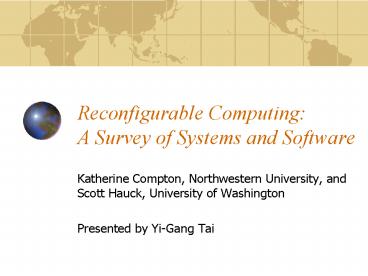Reconfigurable Computing: A Survey of Systems and Software - PowerPoint PPT Presentation
1 / 30
Title:
Reconfigurable Computing: A Survey of Systems and Software
Description:
To fill the gap between hardware and software ... Hardware Programmability. Customizing H/W using physical configuration points. SRAM-programmable ... – PowerPoint PPT presentation
Number of Views:31
Avg rating:3.0/5.0
Title: Reconfigurable Computing: A Survey of Systems and Software
1
Reconfigurable Computing A Survey of Systems
and Software
- Katherine Compton, Northwestern University,
andScott Hauck, University of Washington - Presented by Yi-Gang Tai
2
Content
- Introduction
- Technology
- Hardware
- Software
- Run-time reconfiguration (RTR)
- Conclusion
3
Introduction
4
Conventional Computing
- Hardwired technology ASIC or board-level
solution - Fast and efficient
- Expensive to redesign/refabricate
- Software-programmed microprocessors
- Flexible
- Performance may suffer
5
Reconfigurable Computing
- To fill the gap between hardware and software
- Major technology field-programmable gate arrays
(FPGAs) - Programmable computational elements
- Programmable routing resources
- Digital circuit can be configured to H/W
6
Reconfigurable Systems
- Typically formed with a combination of
reconfigurable logic and a general-purpose
microprocesor - Computational cores mapped to reconfigurable
hardware - The processor performs operations not efficient
in reconfigurable logic
7
Compilation and RTR
- Compilation environments
- To assist programmers in mapping algorithms to
H/W - Run-time reconfiguration
- Device capacity a concern an entire program may
not fit into the device - Reconfigure during program execution
8
Technology
9
Hardware Programmability
- Customizing H/W using physical configuration
points - SRAM-programmable
- SRAM bits connected to the configuration points
- Programming SRAM bits configures the FPGA
10
Configuring Routing
- Programming bit connecting to SRAM and
functioning as a switch - A device could have millions of routing points
11
Controlling Multiplexers
- To choose between output of different logic
resources - For example, to select output from a stateholding
D flip-flop (DFF)
12
Configuring Computational Unit
- Controlling ALU
- Configuring lookup table (LUT)
- LUTs are basically small memories
- A 3-input LUT
13
Hardware
14
Reconfigurable Computing Systems
- Frequently coupled with a general-purpose
processor - Controlling the reconfigurable logic
- Executing program code not efficient in
reconfigurable logic - Two phases of run-time operation
- Configuration
- Execution
15
Coupling
- Closely coupled and loosely coupled
- Tradeoff between benefits and drawbacks
16
Typical FPGA
- LUT-based Logic blocks
- Island-style routing resources
- Most current FPGAs use less than 10 for logic
blocks
17
A Basic Logic Block
18
Logic Block Granularity
- FPGAs based on a set of computation structures
repeated to form an array - Logic blocks vary in complexity
- From fine-grained to coarse-grained
- Three input LUT-based
- 4-bit ALU
- Word-width processing elements
- Most current FPGAs are medium-grained,
heterogeneous arrays - Use configurable multiplier, memory, etc.
19
A Generic Island-style Routing Architecture
20
Segmented and Hierarchical Routing Structures
21
Software
22
Design Flows
23
Issues on Software
- Hardware/software partitioning
- Circuit specification
- Structural
- Behavioral
- Circuit libraries
- Circuit Generators
- Parallelization
- Simulation
24
Run-time Reconfiguration (RTR)
25
Run-time Reconfiguration
- Configurations are too many or too complex to be
loaded simultaneously - The concept of virtual hardware similar to
virtual memory
26
Reconfigurable Models
27
Pipeline Reconfigurable
28
Fast Configuration
- Configuration of entire logic takes hundreds of
milliseconds - To reduce the configuration overhead
- Configuration prefetching
- Configuration compression
- Relocation and defragmentation
- Configuration caching
29
Conclusion
30
Conclusion
- Reconfigurable computing is becoming an important
research area - It combines benefits from both S/W and ASIC
implementations - Computationally intense portions of an
application can be put onto the reconfigurable
H/W to increase performance































